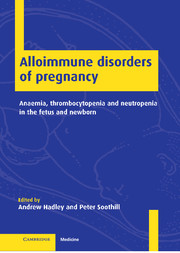 Alloimmune Disorders of Pregnancy
Alloimmune Disorders of Pregnancy Book contents
- Frontmatter
- Contents
- List of contributors
- Preface
- Foreword
- List of abbreviations
- 1 Pathophysiology of the alloimmune cytopenias
- 2 Blood group antibodies in haemolytic disease of the fetus and newborn
- 3 Basis and practice of screening for haemolytic disease of the fetus and newborn
- 4 Epidemiology and screening for alloimmune thrombocytopenia
- 5 Principles of antibody-mediated immune suppression and the prevention of maternal RhD alloimmunization
- 6 The clinical application of anti-D prophylaxis
- 7 Fetal genotyping
- 8 Laboratory assays to determine the severity of haemolytic disease of the fetus and newborn
- 9 Assessing the severity of haemolytic disease of the fetus and newborn: clinical aspects
- 10 Antenatal therapy for haemolytic disease of the fetus and newborn
- 11 Neonatal therapy for haemolytic disease of the newborn
- 12 The diagnosis of alloimmune thrombocytopenia
- 13 The immunological diagnosis of alloimmune neutropenia
- 14 Fetal and neonatal treatment of alloimmune thrombocytopenia
- Index
6 - The clinical application of anti-D prophylaxis
Published online by Cambridge University Press: 26 October 2009
- Frontmatter
- Contents
- List of contributors
- Preface
- Foreword
- List of abbreviations
- 1 Pathophysiology of the alloimmune cytopenias
- 2 Blood group antibodies in haemolytic disease of the fetus and newborn
- 3 Basis and practice of screening for haemolytic disease of the fetus and newborn
- 4 Epidemiology and screening for alloimmune thrombocytopenia
- 5 Principles of antibody-mediated immune suppression and the prevention of maternal RhD alloimmunization
- 6 The clinical application of anti-D prophylaxis
- 7 Fetal genotyping
- 8 Laboratory assays to determine the severity of haemolytic disease of the fetus and newborn
- 9 Assessing the severity of haemolytic disease of the fetus and newborn: clinical aspects
- 10 Antenatal therapy for haemolytic disease of the fetus and newborn
- 11 Neonatal therapy for haemolytic disease of the newborn
- 12 The diagnosis of alloimmune thrombocytopenia
- 13 The immunological diagnosis of alloimmune neutropenia
- 14 Fetal and neonatal treatment of alloimmune thrombocytopenia
- Index
Summary
Epidemiology
Causes and incidence of alloimmunization
Anti-D is still the commonest cause of moderate and severe haemolytic disease of the fetus and newborn (HDFN) in the developed world. Alloimmunization after pregnancy with a D-positive baby is not as frequent as might be expected from the predicted incidence of D incompatibility between father and mother (60% of Dnegative pregnant women carry a D-positive fetus). There are a number of reasons for this. First, the volume of fetal cells crossing the placenta may be too small to initiate a response. Second, ABO incompatibility between mother and fetus offers some protection. Third, the Rh phenotype of the fetus affects antigenicity. Fourth, some women appear to be better responders to a small antigenic stimulus than others. About 17% of at-risk unprotected women are immunized by an ABO compatible pregnancy. Only 8% develop anti-D in the 6 months following a first pregnancy, but a further 9% develop anti-D early in a subsequent pregnancy, indicating that they had been ‘sensitized’ by the earlier pregnancy.
Ethnic groups
About 15–17% of the UK white population is D negative, and a similar approximation can be made for the Caucasian populations of North America, Europe, Australia and New Zealand. The incidence of D negatives is about 10% in Arabs, about 5% in ethnic blacks, 4–10% in Asian Indians and less than 1% in ethnic Chinese. HDFN associated with anti-D is therefore largely a disease affecting Caucasians, and Caucasians thus form a target for cost-effective preventive prophylaxis programmes.
- Type
- Chapter
- Information
- Alloimmune Disorders of PregnancyAnaemia, Thrombocytopenia and Neutropenia in the Fetus and Newborn, pp. 97 - 120Publisher: Cambridge University PressPrint publication year: 2001
- 1
- Cited by
